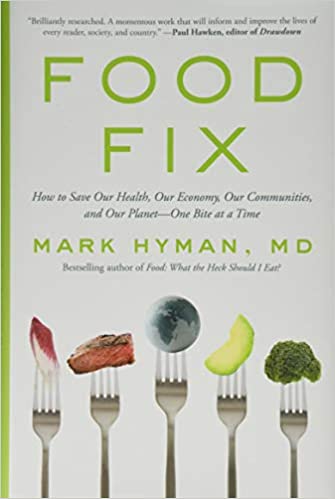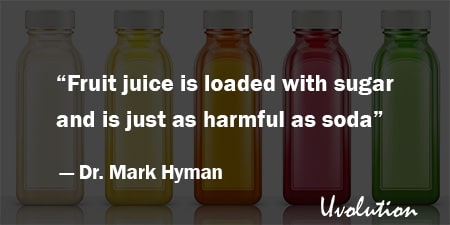Food Fix by Dr. Mark Hyman Book Summary
The Book in 1 Sentences
Food Fix: How to Save Our Health, Our Economy, Our Communities, and Our Planet--One Bite at a Time
“There is one place that nearly everything that matters in the world today converges: our food and our food system—the complex web of how we grow food, how we produce, distribute, and promote it; what we eat, what we waste, and the policies that perpetuate unimaginable suffering and destruction across the globe that deplete our human, social, economic, and natural capital.
Food is the nexus of most of our world’s health, economic, environmental, climate, social, and even political crises. While this may seem like an exaggeration, it is not.
The problem is much worse than we think. After reading Food Fix you will be able to connect the dots of this largely invisible crisis and understand why fixing our food system is central to the health and well-being of our population, our environment, our climate, our economy, and our very survival as a species.
You will also understand the forces, businesses, and policies driving the catastrophe, and the people, businesses, and governments that are providing hope and a path to fixing our dysfunctional food system.”
“The story of food shocked me, frightened me, and drove me to tell this story and to find the possibility of redemption from the broken system that is slowly destroying the people and things we love most.” ~ Dr. Mark Hyman
6 BIG Ideas
Food Fix Book Summary
“If we were to identify one big lever to pull to improve global health, create economic abundance, reduce social injustice and mental illness, restore environmental health, and reverse climate change, it would be transforming our entire food system. That is the most important work of our time—work that must begin now.”
1. The true cost of food
“While Democrats argue to create Medicare for All and Republicans argue to reduce entitlements to bring down our $22 trillion national debt, both are missing the obvious fact.
Fix the reason why we have those costs in the first place. Stop the flow of sick people into the system and the harm to our environment and climate by fixing the cause: the food system. ...
Yet most of our government’s policies promote the growing, producing, marketing, sale, and
consumption of the worst diet on the planet—billions in subsidies (known as crop insurance
or other supports) for commodity crops turned into food and food for factory-farmed animals;
$75 billion a year in food stamps payments that effectively reduce hunger but are mostly for
processed food and soda; unregulated food marketing of soda and junk food; confusing food
labels; industry-influenced dietary guidelines; and more.”
“Chronic disease is now the single biggest threat to global economic development. Life-style-caused diseases such as heart disease, diabetes, and cancer now kill nearly 50 million people
a year, more than twice as many as die from infectious disease.
Two billion people go to bed overweight and 800 million go to bed hungry in the world today. One in two Americans and one in four teenagers have pre-diabetes or type 2 diabetes.”
"Here was the question: Wouldn’t it make more sense to address the root cause of chronic
disease that are driving the costs, rather than trying to clean up after the fact? The room of
300 people went silent.
It was as if I had just revealed the meaning of life. Afterward the panel moderator, the dean of Columbia University’s School of Public Health, told me how profound the insight was and how all the health leaders were talking about it after. Really? I was shocked. This is so obvious, yet no one had thought of it.”
Shocking facts..
“Children born today are expected to live shorter, sicker lives than their parents. The average child born today will live five fewer years than their parents, and if they are poor or socially disadvantaged, they will live 10 to 20 fewer years than their parents.”
“For every 10 percent of your diet that comes from processed food, your risk of death goes up 14 percent.”
“Ultraprocessed foods and the food system that produces them are at the root of the chronic
diseases that account for 80 percent of the deaths from noncommunicable disease worldwide (heart disease, diabetes, cancer, etc.).”
2. Don’t drink sugar
“Stop drinking sugary beverages. If you’ve gotten this far, then my next recommendation
probably goes without saying, but I’ll say it anyway: Don’t drink sugar.
The best way to reform the food system is to make sugar-laden foods less profitable. If consumers demand healthy products, then eventually companies will have to comply.
It’s not just soda. Fruit juice has a health halo. But don’t be fooled by its vitamins and antioxidants. Fruit juice is loaded with sugar and is just as harmful as soda. Avoid buying it, and certainly don’t give it to your children.
Cutting sugar-sweetened beverages from your diet is the single-biggest thing you can do to
improve your health.”
3. The dirty politics of food
“Companies are required to list ingredients in the order of their pre-dominance. But that doesn’t tell you how much is in the package. If sugar is the second ingredient listed on a package, that doesn’t tell you if it makes up 30 percent of the food or 5 percent.
Have you ever picked up a jar of strawberry jam at the supermarket and looked at its ingredient list? A jar of Smucker’s strawberry jam lists strawberries as the first ingredient, and then the second, third, and fourth ingredients are as follows: high-fructose corn syrup, corn syrup, and sugar. This tactic is very common.
The reason companies often use several sweeteners in one product is so they don’t have to list ‘sugar’ as the first ingredient. As [Jerold] Mande[, a nutrition expert who worked on food labels at the FDA and USDA,] explained, ‘What we know from some investigations is that companies often use five different sugars in their products so that they don’t show up high on the list.’”
4. All calories are not the same
“Science definitively proves that all calories are not the same: Sugar and starch calories act
completely differently than calories from fat when you eat them.
In a 2018 Harvard study, researchers fed two groups identical numbers of calories, but one group ate 60 percent of calories from fat with less than 20 percent from carbs while the other group had 60 percent from carbs and 10 percent from fat.
In the most overweight of the participants, the low-carb, high-fat group burned 400 more calories a day without any more exercise, and while eating the exact same number of calories.
Sugar slows your metabolism. Fat speeds it up.
Calories are information, instructions that affect hormones, brain chemistry, the immune
system, the microbiome, gene expression, and metabolism. The energy-balance hypothesis is
dead—except in the minds of those in the fast-food industry because they have a stake in pushing the idea that weight is all about calories in and calories out.
But any third grader could tell you that 1,000 calories of soda and 1,000 calories of broccoli have profoundly different effects on the body.”
Shocking facts..
“In total, Coke provided more than $120 million to US universities, health organizations, and research institutions between 2010 and 2015. From 2008 to 2016 Coke funded 389 articles in 169 journals concluding that physical activity was more important than diet and that soft drinks and sugar are essentially harmless.”
“The food industry spends more than $12 billion a year funding nutrition studies (while the NIH [National Institute of Health] spends only $1 billion), polluting and diluting independent research, and confusing policy makers, the public, and even most doctors and nutritionists. Studies funded by the food industry are eight to fifty times more likely to find a positive outcome for their products.”
“Twix is a health food according to the American Heart Association, in case you weren’t aware—and so are Froot Loops, Cocoa Puffs, and French Toast Crunch, right along with the 7 teaspoons of sugar per serving. It shouldn’t be called breakfast; it should be called dessert.
When you grind it into flour, whole wheat or not, it is worse than sugar. The glycemic
index of sugar is 65 and that of whole wheat bread is 75, which means that the bread raises
your blood sugar more than table sugar. Below the neck, there is no difference between a bowl of sugar and whole wheat bread. Well, actually, the bread is worse.”
“With almost ten times as much of this ‘junk’ research on junk food as of true independent science, the public, the media, and the policy makers stay confused.”
So, “As Vani Hari says in her book Feeding You Lies, ‘You wouldn’t believe a study on cigarettes that was funded by Phillip Morris, and you probably shouldn’t believe a study on cereal paid for by a company whose bottom line depends on Froot Loops, Apple Jacks, and Frosted Flakes.’”
And always remember to “Eat real food, or if you have packaged food, make sure every ingredient is something you recognize or would have in your kitchen and use in cooking. No one has azodicarbonamide, mono- or diglycerides, BHT, or carrageenan in their cupboards. An egg or an almond or avocado doesn’t have an ingredient list or nutrition facts label.”
5. The hidden oppression of big food
“Of all deaths, 1.1 percent are caused by gun violence. Seventy thousand people die every year from the opioid epidemic. Those problems are real and tragic and need to end.
But 70 percent of deaths, or more than 1.7 million deaths a year, are caused by chronic disease such as heart disease, diabetes, cancer, high blood pressure, and stroke—mostly the result of our toxic food system.
More African Americans, Hispanics, and poor people are killed by bad food than anything else. Drive-through fast food kills far more people than drive-by shootings. Yet we remain silent about the role of the food system killing millions of Americans.”
“A 2016 JAMA landmark study compared the difference in life expectancy between the richest and poorest 1 percent of the population. The difference between those two groups
was 15 years for men and 10 years for women. That is equivalent to the loss of life expectancy that results from a lifetime of smoking. More than 38 million Americans live in poverty and almost 100 million live in near poverty.”
“Food is a social justice issue. Our industrial food system is an invisible form of oppression.”
“The big food companies target black and Hispanic youth with their least nutritious products, including fast food, candy, sugary drinks, and snacks. From 2013 to 2017, food advertising on black-targeted TV increased by 50 percent. Black teens viewed 119 percent more junk-food-related ads—mostly for soda and candy—than white teens.”
“Approximately 60 percent of our calories in the United States come from ultraprocessed foods, with the poor, minorities, the young, and the less educated consuming the most.”
6. Regenerative agriculture
“Regenerative agriculture on farms, grasslands, and rangelands is the most powerful force for
fixing much of what’s wrong with agriculture while producing more and better food. And the
practice can be adapted across diverse and global environments. ...
We need to quickly and radically change how we grow food and change the food we eat. But our systems and policies make it hard for farmers who want to do the right thing. Farmers growing healthy food, using sustainable, organic, or regenerative methods, often impoverish themselves to grow food for the rich, while conventional corporate farmers supported by our government get rich growing food for the poor. This must change and is changing.
The good news: It turns out that regenerative agriculture is more profitable (for farmers, not
Big Ag or Big Food) and produces higher yields and better-quality food, even when used to grow commodity crops (soy, corn, wheat), all while reversing climate change, conserving water, and increasing biodiversity!”
That was my QUICK summary of the great book Food Fix by Dr. Mark Hyman. If you’re interested, get your copy. There is a HUGE amount of life-changing ideas in this book, and we’ve only touched on a tiny bit of it.
Buy The Book: Food Fix by Dr. Mark Hyman

GET Blinkist 7 Days FREE Trial
3000+ Book Summaries
(Audio and Text)








